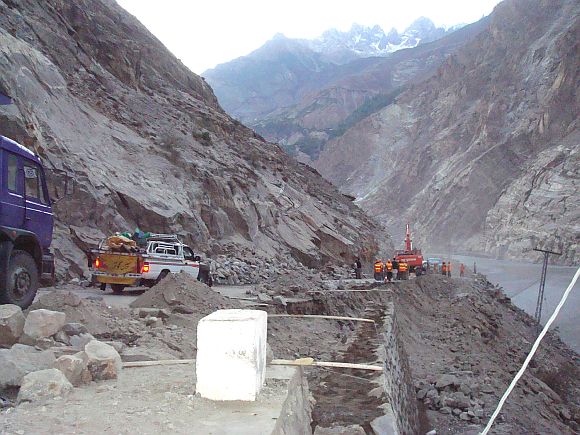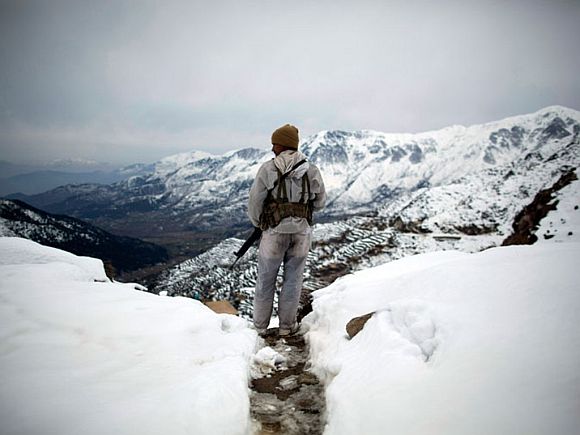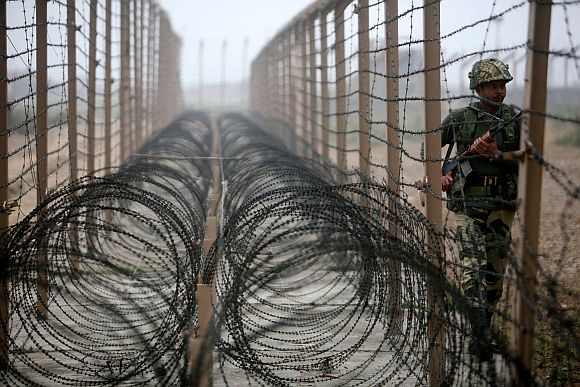Prakash Katoch for Centre for Land Warfare Studies
There's ample proof of Chinese irredentism. China is preparing for a future large-scale conventional wars (informationised and mechanised included) on 'multiple fronts' against India. Prakash Katoch, a veteran Lieutenant General of the Indian Army, explains.
The Himalayan plunder by China began silently in 1950's by transcending boundaries of Tibet and steamrolling occupation of Aksai Chin (38,000 square kilometers) that was part of Ladakh region of J&K acceded by Maharaja Gulab Singh to India post Partition.
China's National Highway 219, re-paved recently, runs now through Aksai Chin connecting Tibet with the Xinjiang region.
This Chinese move was not a mere territory grab but part of a larger integrated politico-military strategy that looked far into future considering long term requirements of resources, particularly energy, that would increase in gargantuan proportions, plus the security of the long supply lines.
China appreciated long back that gas and oil pipelines could be planned in all directions and feasibility of tapping energy in the west / CAR incorporating energy based Eurasian Security Architecture existed.
However, for ultimate energy security, it was necessary to get to the warm waters of the Indian Ocean by land.
The latter was no easy task; it implied patience bordering banality and a long gestation period, plus the Himalayan Massif in the south.
...
Column courtesy: Centre for Land Warfare Studies
India, beware of China's Himalayan moves!
In Pakistan, perpetually in search of its identity, China found an easy ally.
Zhou-en-Lai visiting Pakistan in early 1960s advised Ayub Khan to raise a militia to fight in the backyard of enemy India, offered arms, technologies and a grateful Pakistan ceded Shaksgam Valley (about 6,000 square kilometers of Indian Territory) to China.
This was followed by China supplying nuclear technology and ring magnets to Pakistan and the 'Higher than the Mountains, Deeper than the Ocean' relationship took off.
Simultaneously, China went for maximum economic and military cooperation with the military junta in Burma (now Myanmar) developing North-South waterways by making their waters navigable by large vessels, plus road construction and other development projects.
China resolved her borders with all countries less India and Bhutan, which was by design.
In certain areas Chinese claim lines kept extending progressively as the years went by -- from 1959 claim line to more demanding one in 1963 and subsequently extending further in 1969, 1975 so forth and so on.
China had experienced the success of Mao's guerilla army over the years. It was this, which led Zhu to advise Ayub to raise a militia (today'sjihadis) to fight in India's backyard.
...
India, beware of China's Himalayan moves!
Then came the massive US assistance to Pakistan in creating Taliban for ousting the Soviets from Afghanistan. China watched these developments keenly including the speed with which the Taliban captured Kabul assisted by Pakistani Army regulars disguised as Taliban.
In time, China developed links with the Taliban which came in handy in the later years.
Concurrent to US invasion of Afghanistan in 2001, China was already providing training to Taliban in Xinjiang region.
In more recent years, China has reportedly been supplying arms to the Taliban and even military advisors for fighting the NATO-led ISAF.
The fact that the roots of Nepal's Maoist insurgency lay in Beijing is no secret and these were not limited to ideological support, as in case of similar insurgencies elsewhere and the global ideological spread spearheaded by China's Ministry of Foreign Liaison.
China has provided support to Pakistan's anti-India jihad including at the UN. China gave sanctuary to UFA insurgents when routed from Bhutan by RBA.
More recently, Chinese national were caught with fake Indian documents on mission to contact insurgents in India's northeast.
...
India, beware of China's Himalayan moves!
Image: Chinese construction firms widening the 335km Karakurum Highway (KKH) from Khunjerab to Raikot.China is in contact with Indian Maoists through Nepalese Maoists.
Since last year, Chinese assault rifles and communication equipment are being pumped into India through the Kachen rebels in Myanmar; to insurgents in Manipur and Indian Maoists.
During a recent international seminar, a PLA colonel stated that such activities by Chinese nationals would necessarily be without the knowledge of Chinese government, PLA and Chinese intelligence agencies.
This is difficult to believe, but if true implies that anti-India non-state actors are being allowed to operate in China.
A rapidly radicalising Pakistan also launched an institutionalized jihad to kill maximum 'Shia' in her own territory, particularly Gilgit-Baltistan.
In the Pakistani calculus, subcontracting itself to China was one solution to stabilise the region that would also nip any Indian designs westwards. China naturally grabbed the opportunity, initiating strategic footprints in Pakistan/POK. Reportedly, Pakistan is to lease out Gilgit-Pakistan region to China for 50 years.
One Pakistani analyst predicts Baluchistan becoming a Chinese-administered province by 2030.
...
India, beware of China's Himalayan moves!
Pakistani analysts also say that China wants to establish permanent bases in Pakistan-occupied Kashmir.
PoK will become the geostrategic pivot of China-Pakistan for forays into Afghanistan and Central Asia.
The push to make India withdraw from the Saltoro Range in Siachen area is part of the same plunder of the Himalayas, egged on by the US which in its bid to prop up Kayani appears intransigent of India's strategic disadvantage in the instant case.
The similarities of the military's stranglehold in China and Pakistan are striking; the PLA chief reports to the CCP and not to Chinese government and PLA generals are members of the Politburo. The Military/ISI hold in Pakistan requires no elaboration.
Nepalese Maoists apart, today Chinese are even manning three-star hotels in Kathmandu besides numerous development projects in Nepal.
PLA soldiers in uniform have been sighted in northern Nepal by foreign journalists.
...
India, beware of China's Himalayan moves!
Further east, China has been claiming the Doklam plateau and the road built between Zuri and Phuteogang Ridge that overlooks the disputed Charithang Valley.
Doklam plateau if occupied by China will turn the flanks of Indian defences in Sikkim and endanger the Siliguri Corridor -- the latter becomes an even more serious concern if terrorism gets a surge again in Bangladesh anytime in future with a pro-China-Pakistan regime.
Ironically, India has not even objected to Chinese activities in the PoK.
China hitherto was laying claims only to Tawang, but has suddenly staked its claim to entire Arunachal Pradesh, that too having got Tibet on a plate.
What more proof is needed of Chinese irredentism? This is perhaps the ultimate objective in Operation 'Himalayan Plunder' for gaining control of the Himalayas right from PoK all the way to Arunachal.
Further, plans to reach the Indian Ocean will be put in place thereafter.
China is preparing for a future large-scale conventional wars (informationised and mechanised included) on 'multiple fronts' against India. Let us not be led astray that China's development of a globally deployable military force will only be focused on South China Sea for the next couple of years.







article